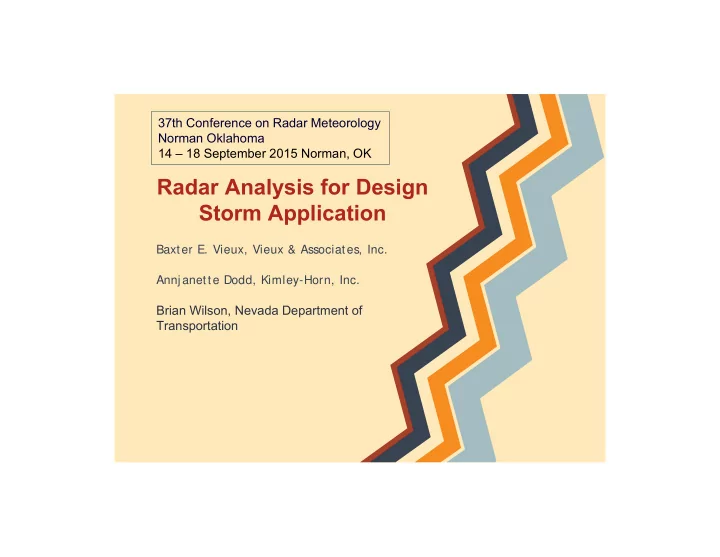

37th Conference on Radar Meteorology Norman Oklahoma 14 – 18 September 2015 Norman, OK Radar Analysis for Design Storm Application Baxter E. Vieux, Vieux & Associates, Inc. Annj anette Dodd, Kimley-Horn, Inc. Brian Wilson, Nevada Department of Transportation
Research Objectives Develop a design storm that is more representative of rainfall in Nevada for drainage infrastructure design Nevada Department of Tranportation Goals- 1. Develop representative temporal distributions called a hyetograph 2. Develop point-to-area relationships for applying rainfall depths of specific return interval, called a Depth-area- reduction-factor (DARF) 2
Research Components 1. Hyetograph (design 2. Depth-area-reduction-factor storm distribution) (DARF) Temporal Synthesis Areal Synthesis 3
Methodology 1. Establish radar-based storm event list 2. Convert reflectivity to rainfall 3. Aggregate storm to specific durations 4. Develop depth-area-duration (DAD) values and select for maximum depth Develop 50 th and 90 th DARF relationships 5. 6. Compare results to historical studies in western US Recommend 50 th or 90 th DARF based on 7. hydrologic evaluation for use statewide 4
WSR-88D Stations Radar Stations and Data (2005 – 2014) • KRGX (Reno, NV) • KLRX (Elko, NV) • KESX (Las Vegas, NV) • KICX (Cedar City, UT) 5
Storm Event Selection Seasonal Distribution Events identified fron NWS flash flood warning or flood advisory ( NCDC 2005-2014) • 138 flash flood reports within HHAs 1-8 • Convective storms during the peak NAM months, with 83% falling in July–September. HHA 1 2 3 4 5 6 7 8 Total No. of 39 48 36 42 103 34 144 101 547 Events 6
Distribution of Duration-Based Storm Events • Events in each of 8 Hydrometeorologically Homogeneous Areas (HHAs) targeted • Radar reflectivity (Z) data converted to rainfall (R) using a putative relationship 1.4 Z=300R • Resulting (unadj usted) rainfall used to compute relative depths for point/ area ratios • Exclude radar storm totals that are not useful 7
Example Radar QC Terrain induced Bright banding that Considered ideal radar returns (AP) that occurred across event that occurred across occurred across HHA 1 HHA 8 during the HHA 11 during the during the 6/8/2009 11/26/2008 event 6/10/2013 event event 8
Develop Depth-Area-Duration (DAD) Values • From the storm event aggregations, depth-area- duration (D-A-D) values were computed. • Area was determined for the average storm total depths >0.25-inches • D-A-D period with the maximum depth selected for analysis 9
Depth-Area North American Monsoon 2014 Storm Total - 6-hr Aggregations SOUTHERN NEVADA from 8-Sep-14 to 9-Sep-14 6-HR DURATION 8-Sep-14 21:00 9-Sep-14 2:00 1.20 1.00 0.80 DARF 0.60 9-Sep-14 2:00 0.40 0.20 8-Sep-14 21:00 0.00 0 500 1000 1500 AREA (SQ. KM.) 10
DARFs at 90 th and 50 th Percentile HHA 1 – 1hr HHA 1 – 12hr ~0.4 HHA 8 – 1hr HHA 8 – 12hr 11
Walnut Gulch Arizona Geographically Fixed • USDA Agricultural Research Service (ARS) in the Walnut Gulch watershed located near Tucson, AZ, 388 sq. km. (150 sq. mi.) • GF analysis of network consisting of 107 gauges at an average elevation of 4,656-ft. msl. 6-hr duration DARF curves for Walnut • DARF in close agreement for Gulch (blue) and median DARF curves areas from 0- to 50-sq. mi. for HHA 1 through HHA 8 (red)
Texas Department of Transportation • Olivera et al. (2005) statewide analysis for Texas Department of Transportation (TXDOT) • Composed of storms from a two- year period using radar data at 4x4-km resolution in an SC-type analysis framework. • DARF for HHA 1 – 8 compare well 1-hr duration DARF curves for in shape, but with less reduction. TXDOT (blue) and median DARF • Shape is encouraging given that curves for HHA 1 through HHA 8 the TXDOT study is radar based (red) and comprises many storms • Climatological differences may produce larger storm cells in Texas than Nevada
Comparison 14
Statewide 90 th Percentile DARFs 1.00 �� � ���� � 1 � 0.90 � � � � 0.80 0.70 0.60 DARF 24hr 0.50 12hr 0.40 6hr 3hr 0.30 2hr 1 hr 0.20 Difference in DARF values across the state is < 0.15 for 0.10 durations of 1-hr at areas of 259 sq.km. 0.00 0 500 1000 1500 Area (sq. km.) 15
Summary New streamlined design storm procedures have been developed for the Nevada Department of Transportation. • Radar data provided essential data for 547 events and 1,720 different durations • Developed DARF relationships for 1, 2, 3, 6, 12, and 24hr durations at 50 th and 90 th percentile, statewide • Importance of analyzing a large number of events is emphasized by the variation in DARFs for a given duration and area 16
Questions ? Baxter E. Vieux, PhD, PE Vieux & Associates, Inc. 350 David L. Boren Blvd. Suite 2500 Norman, OK 73072 www.vieuxinc.com Baxter.Vieux@vieuxinc.com 405 325-1818 17
Recommend
More recommend